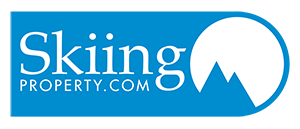Posted on 10 March 2024
When looking at skiing holidays, many ask if Whistler is better than the Alps. The two titans of skiing are both award-winning destinations known around the globe. Whether you’re looking for gentle slopes and thrilling challenges or are an athletic skier hungry for adrenaline-pumping adventures, both destinations offer excitement. Join us as we delve into the features and attractions of each, from Whistler’s legendary heli-skiing to the awe-inspiring terrain of European Alpine regions.
Whistler Blackcomb in North American Versus the European Alps
Whistler Blackcomb: King of Skiing in North America
Sitting in the breathtaking Coast Mountains of British Columbia and belonging to the Vail Resorts collection, Whistler Blackcomb proudly holds the title of North America’s largest ski resort and attracts many keen skiers. With unique terrain and state-of-the-art lift infrastructure boasting modern lifts, Whistler Blackcomb offers unrivalled skiing. From beginner slopes to heart-stopping double black diamond runs, there’s something for every level of skier.
Piste gradings ensure visitors easily navigate the terrain. At the same time, Whistler Heli-skiing provides access to expert terrain and untouched powder for the ultimate backcountry adventure. With 8,000 acres of terrain, the resort boasts over 200 marked trails, ranging from beginner to expert. It offers world-class ski facilities and backcountry skiing opportunities.
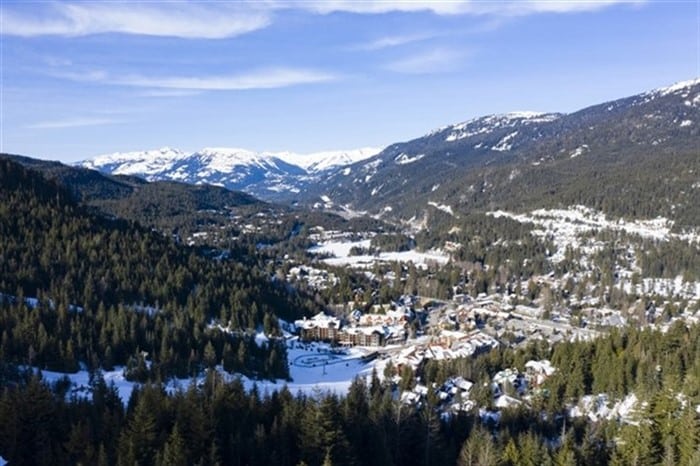
Whistler is approximately 120 kilometres north of Vancouver and encompasses Whistler Mountain and Blackcomb Mountain. Skiing seasons typically run from late November to late April. While Whistler’s permanent population is relatively small, hovering around 12,000 residents, the town sees increased yearly tourists, making this one of Canada’s most popular tourist destinations.
The town’s fame was significantly heightened as a host during the 2010 Winter Olympics. This prestigious event showcased Whistler’s exceptional skiing conditions, top-notch facilities, and breathtaking scenery, further solidifying this premier destination for winter sports.
Pros of Whistler Blackcomb
Extensive Terrain and Scenery: Whistler Blackcomb boasts the largest skiable area, offering vast terrain. Whistler Blackcomb provides breathtaking views of snow-capped peaks and alpine vistas in the picturesque Coast Mountains of British Columbia.
Snow Quality and Facilities: The resort receives abundant snowfall annually, providing excellent skiing conditions throughout the winter season. The resort features modern lifts, well-maintained slopes, and top-notch amenities, including restaurants, shops, and accommodations.
Apres-Ski and Activities: Whistler Village offers lively après-ski atmospheres with numerous bars, and restaurants, to enjoy after a day on the slopes. In addition to skiing and snowboarding, Whistler’s outdoor activities, include hiking, mountain biking, and zip-lining during summer months.
Cons of Whistler Blackcomb
Crowds and High Costs: Being a popular ski resort, Whistler Blackcomb gets crowded during peak seasons, leading to long lines and crowded slopes. Accommodation, lift tickets, and dining are expensive, making it less accessible for budget-conscious travellers.
Variable Weather and Distance: While the resort receives ample snowfall, weather conditions can be unpredictable, with occasional rain or warm temperatures affecting snow quality. Whistler is also about a two-hour drive from Vancouver, making transportation to and from the resort challenging, especially during peak travel times.
Terrain and Avalanche: While the resort offers terrain for all levels, beginners may find the abundance of intermediate and advanced slopes somewhat intimidating, with fewer dedicated beginner areas. Given the mountainous terrain and heavy snowfall, avalanches are a risk.
Delightful Skiing in the European Alps
Meanwhile, the Alps are the epitome of alpine beauty and grandeur, attracting skiers with towering peaks, fantastic terrain and legendary lift infrastructure. With world-class resorts scattered across France, Switzerland, Italy, and Austria, the Alps offer diverse skiing trails. Personally, our favourite is France, followed by Switzerland. For many, France is also the best place to ski.
From couloirs of Chamonix to groomed pistes of St. Anton, the Alps cater to every skill level and preference. The terrain in Switzerland and France is the most popular, thanks to steep slopes, wide-open runs, and incredible off-piste opportunities. The Alps are often compared to ski resorts in Colorado, with vast terrain and extensive lift systems. More than 100 million people visit the Alps yearly, proving its popularity.
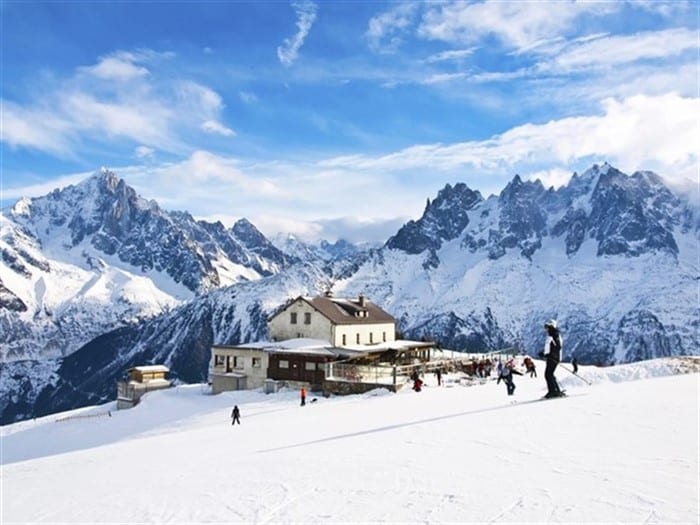
Pros of the European Alps
Diverse Terrain and Scenery: European Alp ranges offer varied terrain, from gentle slopes for beginners to challenging off-piste runs for experts. Skiers enjoy towering peaks, alpine valleys, and picturesque villages, creating stunning backdrops for their skiing holidays.
High Altitude and Ski Areas: Many alpine resorts sit at high altitudes, ensuring good snow conditions throughout winter and often extending well into spring. The Alps boast large interconnected ski areas like Espace Killy, Paradiski, and the Three Valleys, allowing skiers to explore vast networks of slopes and trails without ever skiing the same run twice.
Rich Culture and Accessibility: Immerse oneself in the rich cultural heritage of alpine regions, including traditional cuisine, charming alpine chalet architecture, and vibrant après-ski scenes. The Alps are easily accessible from major European cities, with many resorts within a few hours’ drive or train ride. Geneva airport is also often used, with many resorts within 2 2-hour drive.
Cons of Skiing in the European Alps
Crowds and High Costs: Popular ski resorts get crowded during peak seasons, leading to long lift lines, crowded slopes, and difficulty finding accommodation. Skiing can be expensive, with costs including lift tickets, lodging, equipment rental, and dining, making it less accessible for budget travellers.
Variable Weather: Weather conditions are unpredictable, with snowfall, wind, and temperature fluctuations affecting skiing conditions and visibility. Additionally, global warming is a concern, with habitat disruption, deforestation, and carbon emissions from transportation and resort operations contributing to climate change and environmental issues.
Inbounds Terrain at Whistler Blackcomb
Whistler Blackcomb earns fame for incredible inbounds terrain. Whether you prefer to cruise down groomers, tackle glades, or enjoy above-the-line skiing, there is something for everyone. With meticulously maintained trails, groomers carve through perfectly groomed slopes, enjoying smooth and effortless rides.
For more adventurous holidays, the glades are excellent. The perfectly spaced trees provide thrilling playgrounds for riders to navigate, immersing themselves in stunning alpine scenery. Both mountains, Whistler and Blackcomb, have unique aspects. Blackcomb, for instance, boasts the Blackcomb Glacier, where skiers experience the thrills of glacier skiing. Additionally, Blackcomb offers hike-to-side country terrain, providing access to untouched powder stashes and hidden gems for adventure.
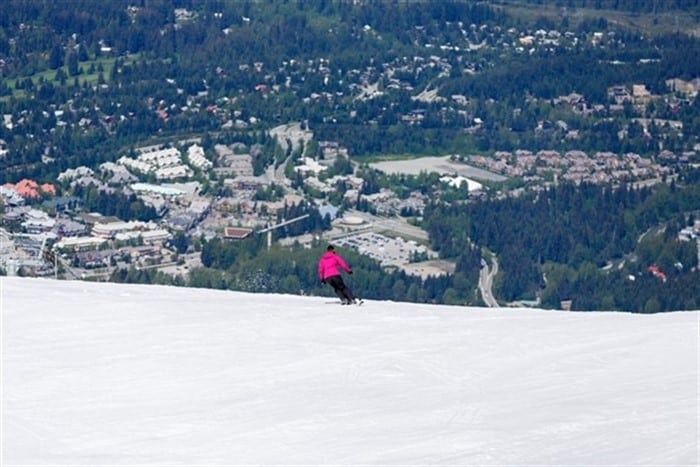
The Whistler side offers diverse pitches and tree skiing. The terrain suits all abilities and preferences, from steep slopes to mellow, tree-lined glades. Some specific areas and lifts that offer enjoyable terrain include the Symphony Amphitheatre, accessed via Symphony Express lift. This area provides steep chutes, open bowls, and tree skiing for advanced skiers and riders. The Harmony Express lift also accesses terrain with pitches, from groomers to glades.
Freestyle enthusiasts showcase skills in meticulously designed terrain parks with jumps, rails, and features. The iconic Peak Chair offers access to Whistler’s most exhilarating terrain, providing riders with panoramic views of surrounding mountains and valleys. Lift passes grant visitors access to Whistler Mountain and Blackcomb Mountain, allowing them to explore vast networks of trails and terrain.
Whistler boasts diverse ski trails, including double black diamonds. Trails are graded based on difficulty, with blue runs suitable for intermediate skiers, and black diamond runs catering to more experienced riders. The resort maintains trails meticulously, ensuring optimal skiing conditions.
For an unparalleled backcountry experience, Whistler offers heli-skiing adventures that provide access to pristine powder stashes and remote alpine terrain. Whistler Heli and other operators offer guided heli-skiing tours, allowing adventurers to explore the rugged beauty of surrounding mountains.
Inbounds Terrain in the European Alps
Inbounds terrain in Switzerland and France offers exceptional skiing with remarkable quality and diversity. With ski resorts scattered across the region, the Alps are paradise. Each resort boasts charm and character, and quality skiing is unparalleled, with pristine slopes, well-groomed trails, and reliable snow conditions.
One key difference between the Alps and North American ski destinations is the more expansive runs offered in the Alps. This allows for more fast and flowing skiing, perfect for those who enjoy cruising down mountains. Additionally, the Alps have fewer moguls and are more accessible for skiers who prefer smoother terrain.
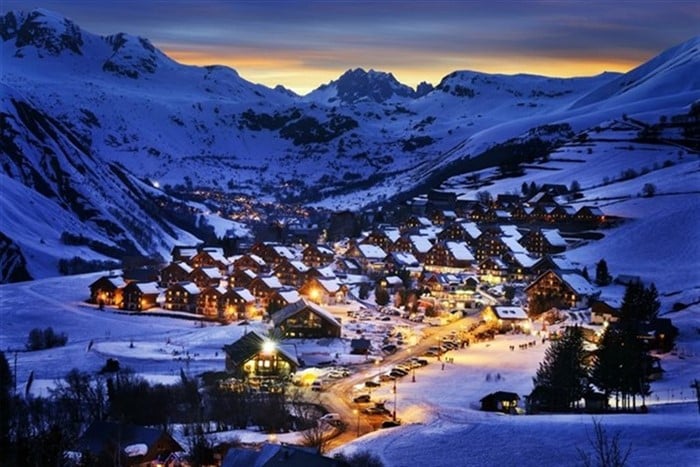
Zermatt, Verbier, and St. Moritz are renowned among the top Swiss ski destinations. With stunning views of the iconic Matterhorn, Zermatt offers an unforgettable skiing. Verbier has off-piste terrain and a vibrant après-ski scene, while St. Moritz combines luxury and world-class skiing.
An exciting feature of European skiing is skiing from Switzerland to Italy in one day. This experience allows skiers to explore different countries and enjoy various slopes and landscapes in a single trip.
European alpine inbound terrains provide exceptional skiing quality and diverse slopes across numerous resorts. With more expansive runs, fewer moguls, and breathtaking views, the Alps offer distinct skiing compared to North American ski destinations. Zermatt, Verbier, and St. Moritz are among the top Swiss ski destinations, each offering attractions. Places like Courchevel in the French Alps are where millionaires, celebrities, and royalty head.
Off-Piste and Ski Touring Opportunities in Whistler
Whistler and Blackcomb mountains in Canada boast incredible off-piste and ski touring opportunities, catering to adventure-seeking skiers and experienced mountain explorers. Blackcomb Mountain has steeper tree runs, providing an adrenaline-pumping experience for thrill-seekers. The tight, winding paths through thick forests create fantastic challenges for advanced skiers. Whistler Mountain offers vast open alpine bowls where skiers can indulge in jaw-dropping panoramic views while carving through untouched powder.
Accessing off-piste areas for skiing and touring these mountains is relatively straightforward. For Whistler, one popular route is through touring up Flute, which allows skiers to access thrilling off-piste areas. On Blackcomb Mountain, climbers head up to the East Col of Blackcomb Peak, which offers access to incredible terrain.
Prominent backcountry skiing trails also attract many adventure enthusiasts. The Musical Bumps trail takes skiers by three prominent peaks and offers breathtaking vistas. Fissile, Whirlwind, Spearhead Glacier, and Circle Lake are famous trails providing unforgettable holidays for off-piste and touring enthusiasts.
Whistler vs European Alpine Villages
When comparing Whistler to European Alpine Villages, one immediately notices North American resorts’ layout differences and approaches overall. Some resorts, like Whistler, offer neutral alpine experiences. In contrast, others, such as Sun Peaks or Kimberley, purposely model themselves after traditional European villages.
One crucial factor is North America’s lack of 600-year-old alpine villages. This naturally limits the ability to replicate the historical charm found in European destinations. Instead, resorts like Whistler create atmospheres that capture the mountains’ essence without trying to imitate specific villages. Another significant factor is the convenience of ski-in ski-out options that both Whistler and European skiing destinations offer.
Apres-Ski Activities at Whistler and in the European Alps
Whistler Blackcomb and the Alps both offer exciting après-ski activities for winter enthusiasts. In Whistler, popular spots for après-ski include Garibaldi Lift Co, Longhorn, Merlin’s, Black’s Pub, and Brandy’s at the Keg. These lively venues are known for vibrant atmospheres, live music, and extensive drink menus, making them perfect for unwinding.
Apart from lively après-ski and vibrant nightlife, Whistler Village boasts outstanding hotels, restaurants and boutique shops. Food enthusiasts indulge in culinary delights, from gourmet cuisine to casual dining options. The village also offers diverse shopping experiences, with trendy boutiques featuring everything from luxury winter gear to souvenirs.
Après-ski culture in France and Switzerland offers a delightful blend of relaxation, indulgence, and vibrant socializing against the backdrop of the majestic Alps. In France, après-ski is an integral part of the skiing experience, with resorts like Chamonix and Courchevel offering various après-ski activities. After all, the tradition does stem from there.
Skiers and snowboarders often unwind in cosy mountain lodges or chic bars, savouring local delicacies such as tartiflette and fondue while enjoying live music or DJ sets. The après-ski scene in France and Switzerland is lively and inclusive, attracting both seasoned athletes and leisure skiers alike, creating a convivial atmosphere where stories of the day’s adventures are shared over glasses of vin chaud or craft beers.
Snow Quality and Ski Season Length at Whistler Versus the Alps
Two key factors often considered when planning ski trips are the snow quality and ski season length. Snow quality refers to condition and density, which significantly impacts overall skiing. Ski seasons refers to how long resorts open for skiing and snowboarding activities. Both these factors determine the success and enjoyment of ski trips.
There are notable differences in snow quality, quantity, and consistency when comparing snow conditions. Whistler Blackcomb, located in British Columbia, Canada, offers exceptional snow quality. Snow here is famously light and dry, often called “champagne powder.” This high-quality snow stems from specific weather patterns, creating ideal conditions for fluffy snowflakes to form. Additionally, the elevated terrain at Whistler Blackcomb, with peaks reaching over 2,000 meters, contributes to preserving snow quality, allowing for longer ski seasons.
The Alps, encompassing multiple European countries, experience different snow that is wetter and heavier than Whistler Blackcomb. Varied climates and lower elevations also result in different snow consistency. Due to the diverse geography and altitudes in the European Alps, snow conditions vary significantly from one region to another. Some resorts even offer summer skiing.
Various factors contribute to snow conditions. Elevation plays a significant role, with Whistler Blackcomb being situated at a higher altitude than most Alpine resorts. Weather patterns in each location, such as prevailing winds and moisture content, also influence snow quantity.
Length of Ski Season in North America vs Europe
Ski seasons in North America and Europe vary significantly according to weather patterns and resort management. In North America, ski seasons typically last from November to April, while in Europe, they last from December to April. North America experiences colder winters and has more significant snowfall compared to Europe. This allows ski resorts to open earlier and extend seasons well into spring. Europe has milder winters, especially in regions closer to the Mediterranean.
Resort management also determines ski season duration. North American ski resorts often invest heavily in snowmaking technology, allowing them to maintain slopes for extended periods, even during warmer spells. In Europe, where snowmaking technology is less prevalent, resorts heavily rely on natural snowfall. However, some resorts are investing more in machines.
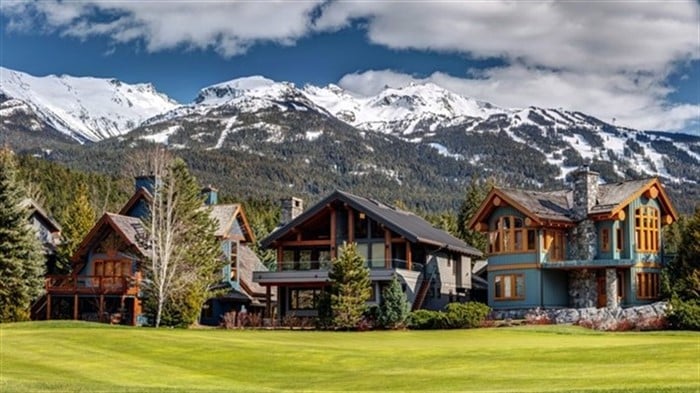
Transfer days and weekend skiing further impact the availability of slopes. Many resorts have designated transfer days, typically Saturdays or Sundays, when guests arrive and depart. This means that these days, slopes are crowded, and availability may be limited. Similarly, weekends tend to see an influx of skiers, reducing the number of available slopes.
High-Speed Chairlifts at Whistler Blackcomb
High-speed chairlifts in Whistler have revolutionized skiing experiences. These state-of-the-art chairlifts provide convenient and efficient ways to access different mountain areas. Skiers easily hop on and off chairlifts at strategic points, allowing them to explore various runs, trails, and terrain parks without navigating complex lifts. The high-speed chairlifts significantly reduced wait times, especially during peak periods. With greater capacity and speed, more skiers are transported up the mountain in less time.
Our Favourite European Resorts – Val d’Isère, Meribel, and Val Thorens
For winter sports, France boasts world-renowned ski resorts. Among standout destinations are Val d’Isère, Meribel, and Val Thorens, each offering breathtaking scenery, impeccable lift infrastructure, and expert terrain catering to skiers of all levels.
These resorts are renowned for extensive ski infrastructure, featuring modern lifts, vast acres of terrain, and well-maintained ski trails. From beginner-friendly green circles to double black diamonds, resorts utilize colour-coded systems to denote trail difficulty, with blue squares ideal for intermediate skiers. In contrast, expert skiers seek out adrenaline rushes of black diamonds and couloirs.
Compared to American counterparts, European resorts like Val d’Isère, Meribel, and Val Thorens often boast larger ski areas and fewer lift lines. Lift queues are generally more manageable, allowing skiers to wait less.
Méribel Couloir Extreme, also known as the Couloir Tournier, is a renowned off-piste skiing route in Méribel ski resort within France’s Three Valleys ski area. With steep gradients and narrow confines, the couloir presents formidable challenges that demand precision, control, and expert navigation skills.
For adrenaline-pumping thrills, the alpine terrain delivers. Expert skiers tackle steep couloirs, navigate through narrow chutes, or carve fresh tracks in untouched powder. Freestyle enthusiasts showcase skills in terrain parks, while intermediate skiers explore groomed trails and scenic routes.
Beyond the slopes, resorts offer diverse culinary offerings to satisfy every palate. From hearty mountain fare to gourmet delicacies, there’s no shortage of dining options. After excellent skiing, skiers unwind with steaming hot chocolate or indulge in après-ski festivities at local bars and restaurants. So, when choosing where to go, Whistler Or the Alps, it all boils down to personal preferences. Still, our article about the European Alps will help you learn more about our favourite place to ski.
Best Ski Resort in the World: Avid skiers and alpine property hunters might think there is no way to judge what the world’s best ski resort is, but there is. After all, everyone’s idea of what is best differs. Still, we can look to official ranking panels and reader surveys from hundreds of people to determine collective opinions. From charming towns in Europe to excellent skiing, snow conditions, and alpine villages, many factors influence whether a ski resort gets the thumbs up or thumbs down.
